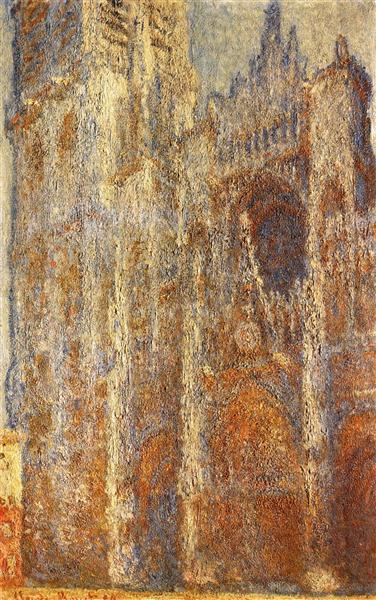Description
The painting "Cathedral of Rouen at noon" by Claude Monet, created in 1894, is a masterpiece that encapsulates the essence of impressionism and the deep commitment of the artist with the exploration of light and the natural atmosphere. Monet, one of the founders of the Impressionist Movement, dedicated a series of works to the representation of the Cathedral of Rouen, a monument that fascinated the artist for his monumentality and the variable interaction with the light at different times of the day.
In this work, the cathedral is represented with a rich and varied palette that illustrates the complexity of noon light on the stone of the cathedral. The technique of loose and visible brushstrokes that characterizes Monet is manifested in the way in which the texture of the stone is captured, as well as the color nuances that fluctuate on the surface. The choice of an almost abstract approach where the forms are hinted instead of being rigidly outlined, allows the viewer to immerse itself in the visual experience of the moment, turning the cathedral into an object of meditation on the fleeting nature of perception.
The composition is imposing, focused on the grandiosity of the cathedral that rises before the viewer. The structure, although recognizable, is blurred in areas, suggesting that the true subject of painting is not only the cathedral itself, but the light that fell on it, a recurring theme in Monet's work. The predominant colors on this canvas include gray, lilacs, and blue, with white flashes that simulate the reflexes of light and shadow. This use of color not only gives life to the cathedral but also invokes a sense of movement and transformation, suggesting the passage of time and its effects on the environment.
It should be noted that Monet's approach in the cathedral was aligned with his interest in color and light variations at different times of the day and under different atmospheric conditions. Compared to other works of the Cathedral series, such as "The Ruan, Ephemeral Cathedral" or "Rouen Cathedral at the time of the sun," this painting stands out for its tonal serenity. The almost ethereal atmosphere invites a reflection that goes beyond the physical, suggesting a sense of spirituality or contemplation, a characteristic feature of his work at this time.
It is interesting to note that Monet did this series of paintings While living in Giverny, where he began experimenting with color and light in a way that would influence future artist generations. His dedication to this topic reflects his desire to capture the essence of visual and emotional experience, a principle that would become the cornerstone of impressionism. The work "Cathedral of Rouen at noon" not only presents an emblematic building, but also stands as a testimony of the ability of art to transform everyday perception into something sublime and relevant.
When observing this painting, the spectator is not only before a representation of a place, but also before an invitation to contemplate the ephemeral beauty of light and its power to alter our perception of time and space. Monet, through his distinctive style, challenges the observer to imagine not only what is seen, but also what he feels, turning the mundane into a field of lyrical possibility.
KUADROS ©, a famous paint on your wall.
Hand-made oil painting reproductions, with the quality of professional artists and the distinctive seal of KUADROS ©.
Reproduction service paintings With a guarantee of satisfaction. If you are not completely satisfied with the replica of your painting, we refund your money 100%.

